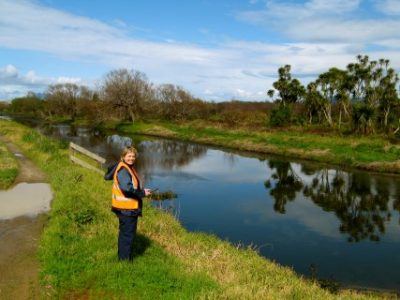St Mary’s Catholic Primary School, Rotorua - Brigitta Nieuboer

2015 | Productivity of mallard ducks nesting around drain habitats
School: St Mary’s Catholic Primary School, Rotorua
Host: Fish and Game, Rotorua
Region: Bay of Plenty
Brigitta Nieuwboer has a passion for engaging children in science, encouraging children to make links with science and the world around them, and fueling children’s curiosity and wonder in all aspects of science.
Brigitta was hosted by the Eastern Region Fish & Game where she assisted with a research project around the productivity of Mallard ducks nesting in and around rural drains. Scientists at Fish & Game believe that Mallard ducks are now predominantly nesting around rural drains as wetland areas diminish, and this research was to identify the characteristics of rural drains, and to be able to identify which combination of these benefits Mallard duck productivity.
Brigitta feels that she has been fortunate to have been part of the Mallard duck research from the beginning, and has experienced the different stages of setting up a research project. She has worked alongside scientists mapping drains and has been involved in fieldwork calculating the number and age of ducklings hatching and in and around selected rural drains over a period of time. As the fieldwork progressed, Brigitta has been able to establish patterns emerging from the data; some drains have broods and ducks, some have only ducks, and others have no ducks. She has also had experience analysing the data gathered during the research. The results from this research will contribute to a better understanding of the characteristics of drains that benefit the reproduction of Mallard ducks, and will be used to inform Regional Councils of possible drain maintenance and vegetation that are beneficial for Mallard ducks during breeding season.
At Eastern Fish & Game, Brigitta gained experience working alongside scientists who work on the trout releasing programme, which focuses on replenishing trout stocks in a number of the surrounding lakes. She helped at the trout trap suituated at one of the local lakes, where trout are caught, weighed and measured. The best quality trout were then taken back to the hatchery and Brigitta was able to participate in a number of activities related to the trout breeding programme.
Brigitta has gained a better understanding of how scientists work in a range of settings, and has had practical experience allowing her to see how the Nature of Science works from a scientist’s perspective in the real world. The experiences that she has gained by working alongside scientists has been incredibly valuable as it has allowed her to make the links between teaching science and how the Nature of Science works in the real world.
Brigitta would like to thank the staff of Fish & Game for sharing their experiences and knowledge with her during her placement, and for their commitment to the Science Teaching Leadership Programme.
